CeBIT 2005 offers an exhibition and conference featuring a worldwide unique compilation of over 800 lectures regarding corporate lectures, platforms and expert conventions, that take care of your status of information regarding new products, procedures, market developments and solutions.Hannover, Germanwww.cebit.de
Month: March 2005
Mobile Virus: MMS Spreads On Symbian
 Symbian OS anti-virus specialist SimWorks, has announced that it has identified the first virus targeting the platform, that is capable of spreading itself via MMS messages.
Symbian OS anti-virus specialist SimWorks, has announced that it has identified the first virus targeting the platform, that is capable of spreading itself via MMS messages.
The virus – named CommWarrior by SimWorks – uses MMS to send itself to any MMS compatible mobile phone, but will only infect phones based on Symbian OS platforms.
Multimedia Message Service (MMS) is a more advanced version of SMS messaging (aka ‘texting’) which allows users to send multimedia content – pictures, sounds and video – as well as applications and text via their handsets.
The virus affects Series 60 smartphones based on Symbian OS 6.1 or newer, such as the Nokia 3650, 6600 and 6630, but devices running on the UIQ platform, such as the Sony Ericsson P900/P910 and Motorola A925/A1000 are unaffected.
The CommWarrior virus works by scanning the infected phone’s address and periodically blasting out MMS messages to randomly selected contacts, including a copy of itself and one of several predefined text messages designed to encourage the recipient to install the application.
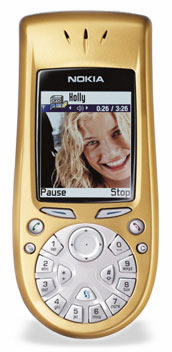 To add insult to injury, users will be punished financially by the virus, with MMS messages typically costing between $0.25 and $1.00 a pop.
To add insult to injury, users will be punished financially by the virus, with MMS messages typically costing between $0.25 and $1.00 a pop.
With the virus doing its devilish work silently in the background, it could be some time before the user becomes aware of the potentially hundreds of MMS messages sent from their handset.
Not happy with trying to propagate via MMS, the sneaky CommWarrior virus also has another tool in its satanic armoury – it attempts to infect nearby devices by means of Bluetooth.
According to SimWorks, CommWarrior is the first mobile virus to use such a low-down, two-pronged distribution strategy, which may allow much faster and more geographically widespread infection of vulnerable devices.
 The good news is that like previous Symbian OS-targeted viruses, users are still required to accept the installation of the virus whether receiving it via Bluetooth or MMS.
The good news is that like previous Symbian OS-targeted viruses, users are still required to accept the installation of the virus whether receiving it via Bluetooth or MMS.
The traditional problems of MMS interoperability amongst mobile network operators could also play a part in slowing the spread of the virus.
But before you all start staring at your mobiles in fear, it should be stated that we don’t know anyone affected by this virus and there’s more than a few cynical voices out there suggesting that that anti-virus software companies are prone to exaggerate the threat in an attempt to shift more products. As if! (cough)
CeBIT Exhibition: Anticipation And Our Coverage
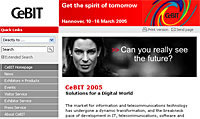 The world’s leading technology tradeshow, CeBIT, starts this Thursday in Hannover, north Germany with pundits expecting the show to reflect the recent stellar growth in the $2 trillion technology industry.
The world’s leading technology tradeshow, CeBIT, starts this Thursday in Hannover, north Germany with pundits expecting the show to reflect the recent stellar growth in the $2 trillion technology industry.
After three slow years, net exhibition space is up from last year at over 316,000 square meters and the organisers are expecting the number of visitors to exceed 510,000 people.
Naturally, Digital-Lifestyles will be there on the ground too, so watch for updates from the show as they happen.
Signs for the industry have been good over the last year with mobile phone unit sales up 30 percent last year and computer shipments rising 15 percent, spurred on by customer-wooing new features such as wireless Internet access, built-in radios and high-quality digital cameras and price cuts.
CeBIT is one of the largest electronics exhibitions in the world – so big, it’s close to frightening. As a guide, there are 6,117 companies from 72 countries taking part this year.
Within the 27 hanger-sized halls, visitors can expect to find a veritable Aladdin’s cave of the latest technologies and services that may well become standard features in a few years time.
Amongst all the technological marvels on display will be Samsung’s humongous 102-inch plasma display panel TV – the world’s largest – LG Electronics’ world’s first 55-inch LCD television, and a 3D monitor display from the German Fraunhofer Institute that allows objects to be manipulated by gestures recognised by bio-sensors.
Naturally, the telecom industry will be out in force, showcasing DMB (digital multimedia broadcasting) phones, 3rd generation camera phones, 3D game phones and a clutch of mega-pixel camera phone.
 As VoIP (Voice over Internet Protocol) continues to gain in popularity, there’ll be dozens of companies showcasing devices to make free calls as well as displays of corded and cordless Skype phones by Siemens, Motorola, Good Way Technologies and Greatwall Infotech.
As VoIP (Voice over Internet Protocol) continues to gain in popularity, there’ll be dozens of companies showcasing devices to make free calls as well as displays of corded and cordless Skype phones by Siemens, Motorola, Good Way Technologies and Greatwall Infotech.
Sony Ericsson will unveil its first phone with a built-in Walkman while Nokia, Samsung and Motorola will be showing off their latest designs.
Naturally, the place will be awash with Wi-Fi and Bluetooth devices so, in theory, we’ve no excuse for not getting our reports out to you on time!
DVB-H: Mobile TV Pilot Begins In Finland
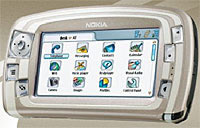 Finnish telecommunications equipment giant Nokia has announced a mobile television pilot, bringing live television broadcasts to mobile devices, starting in Finland today.
Finnish telecommunications equipment giant Nokia has announced a mobile television pilot, bringing live television broadcasts to mobile devices, starting in Finland today.
The pilot is a result of a collaboration between Digita, Elisa, MTV, Nelonen, Nokia, Sonera, YLE (The Finnish Broadcasting Company) and Nokia.
The project tests mobile TV services and consumer experiences, as well as the underlying technology, with 500 users taking part in the trials around the Helsinki capital region.
This trial follows on from a smaller test in Finland in late 2004, where Nokia learned that people liked watching mobile TV just about everywhere – on the move, in work, in pubs/cafes and at home – with news, weather, sports, entertainment and drama and comedy series proving popular.
This new trial employs a selection of Sonera and Elisa mobile phone customers, using specially equipped Nokia 7710 smartphones capable of receiving mobile TV and radio broadcasts.
The Nokia smartphone also enables direct links to the Internet for access to background information on TV programs or sports results, with access to a host of channels including MTV, YLE and Nelonen, CNN, BBC World, Euronews, Eurosport, ViVa Plus and Fashion TV.
Putting together this service has involved the cooperation of several companies, with Elisa and Sonera being responsible for customer service, invoicing and connections to the new interactive supplementary services.
Digita – who designed and built the digital TV network needed for the distribution of mobile TV services – will be responsible for managing the network, while Nokia will develop the mobile TV service management and smartphones that can receive mobile TV broadcasts.
 The mobile TV test uses IP Datacasting (IPDC), which conforms with the DVB-H standard.
The mobile TV test uses IP Datacasting (IPDC), which conforms with the DVB-H standard.
At the end of 2004, the European Telecommunications Standards Institute (ETSI) adopted DVB-H as the standard for European mobile television services, enabling the simultaneous transmission of several television, radio and video channels to mobile devices.
The pilot continues until 20 June 2005. We’re already salivating at the prospect of being able to sit in the pub and get all-interactive with the football action!
New BBC Dr Who Episode Leaked Onto Internet
 An episode of the new series of the sci-fi drama Doctor Who has been leaked onto the Internet, three weeks before the series is expected to begin on BBC One.
An episode of the new series of the sci-fi drama Doctor Who has been leaked onto the Internet, three weeks before the series is expected to begin on BBC One.
The 45 minute episode was being downloaded from at least three bit torrent sites yesterday, although is unclear whether it was the final cut or mid-production ‘rushes’.
Dr Who was first shown on BBC1 in 1963 and its cheap’n’cheerful props, low tech production values and less-than-convincing monsters managed to terrify several generation of viewers.
Under a hail of protests from its hardcore fans, the series – the world’s longest-running science-fiction television programme – ended in 1989, with a one-off movie reprise in 1996.
Reuters are reporting that the BBC is looking into the possible today, “This is a significant breach of copyright which is currently under investigation,” a BBC spokeswoman told Reuters. Commenting on where it came from, they said, “The source of it appears to be connected to our co-production partner,” she added, referring to the Canadian Broadcasting Corp.
In 2003, Dr Who was voted the show people would most like to see back on TV.
 The eagerly awaited new series, filmed in Wales, features the well respected actor Christopher Eccleston as Dr Who, with former teen pop singer Billie Piper as his assistant.
The eagerly awaited new series, filmed in Wales, features the well respected actor Christopher Eccleston as Dr Who, with former teen pop singer Billie Piper as his assistant.
Naturally, we wouldn’t get involved in illegal downloads, but reports suggest that the new series has lost none of its kitschy appeal, with a bizarre plot involving man-eating dustbins and animated mannequins.
Apparently, the Doctor is still flying around the Universe in his trusty Tardis, although the interior has changed with a darker interior and more hi-tech gadgetry.
In one scene, the Doctor watches the Kennedy assassination – a knowing reference to the first-ever episode of the series, which was screened on that fateful day.
Some American sites who have viewed the episode are already giving it less than flattering reviews, but we suspect that’s as much to do with the cultural differences as anything else.
After all, if you haven’t grown up under the threat of the evil Daleks, how could you ever expect anyone to ‘get’ Dr Who?
Game Developers Conference
The Game Developers Conference (GDC) is the official trade event “by game developers for developers” of computer, console, mobile, arcade, online games, and location based entertainment. The GDC attracts over 10,000 attendees and provides educational, networking, and business opportunities for game development professionals driving the $9 billion video game industry. It is the main global forum where programmers, artists, producers, game designers, audio professionals and others involved in the development of interactive games gather to exchange ideas, network, and shape the future of the industry. This market defining conference features over 300 lectures, panels, tutorials and round-table discussions on a comprehensive selection of game development topics taught by leading industry experts. In addition, the GDC expo showcases all of the game development tools, platforms and services. The conference also includes the seventh annual Independent Games Festival, where new, unpublished games compete for the attention of the publishing community.San Francisco, USA http://www.gdconf.com/conference/
Google Desktop Search, Full Release, Searches Audio and Video
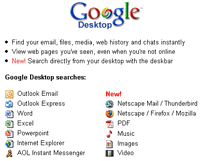 Google has taken its free desktop search tool out of beta and unveiled a finalised version capable of searching the full text of pdf files and the metadata of multimedia files.
Google has taken its free desktop search tool out of beta and unveiled a finalised version capable of searching the full text of pdf files and the metadata of multimedia files.
The beta version could only index the names of such files, but the all-singing final application can index the entire content, including useful data such as song and artist names in music files.
Google product manager Nikhil Bhatla explains: “We’ve taken the product out of beta because now we have all the file types and features that were high on the list of user requests”.
Bhatla also explained that Google hoped that more people would be encouraged to download and install the product now that it’s no longer described as a beta app.
Google introduced its desktop product in October of last year, promptly followed by big search engine providers such as Microsoft, Ask Jeeves, Yahoo and AOL who are all keen to grab a slice of the desktop search market.
Desktop searches are one of the key battlegrounds for search engine companies, who hope that users installing desktop apps will extend their loyalty to the tool maker’s Internet search engine – and thus increase profits from the lucrative, keyword-related online ads market.
 Other improvements in the Google desktop tool are support for Mozilla’s Firefox and Thunderbird applications and AOL’s Netscape browser and e-mail application (previously, the product only supported Internet Explorer and Outlook/Outlook Express).
Other improvements in the Google desktop tool are support for Mozilla’s Firefox and Thunderbird applications and AOL’s Netscape browser and e-mail application (previously, the product only supported Internet Explorer and Outlook/Outlook Express).
The program can now index a veritable army of multimedia files including MP3, WMA, WAV, JPG, GIF, PNG, BMP, AVI, MPG and WMV.
There’s also a growing range of plug-ins available, letting users index content from a wide variety of sources including instant messaging (IM) conversations from Cerulean Studios’ popular Trillian Pro IM application, mIRC, music metadata files acquired from Apple’s iTunes music store and OpenOffice.org and StarOffice documents.
Interestingly, Google are also looking to a third-party developer to create a speech-to-text plug-in to allow the product to transcribe the content of audio and video files and make it searchable – increasing the indexing capabilities of those files beyond metadata.
![]() Although this desktop search tool is designed for use by consumers, Google have their eye on the workplace too, with the program able to recognise Microsoft group policy parameters on a PC.
Although this desktop search tool is designed for use by consumers, Google have their eye on the workplace too, with the program able to recognise Microsoft group policy parameters on a PC.
Fossil Wrist PDA Watch, Much Delayed, Finally Arrives
 It’s been delayed more times than the 8:25 from East Grinstead on a leaf-strewn morning, but Fossil has finally released its super geeky Fossil Wrist PDA Palm Powered watch.
It’s been delayed more times than the 8:25 from East Grinstead on a leaf-strewn morning, but Fossil has finally released its super geeky Fossil Wrist PDA Palm Powered watch.
Based on the Palm OS, the Fossil wrist watch provides full Palm PDA functionality, in a case so chunky that that it could double up as a shield.
First announced way back in late 2002 with a release slated for 2003, the watch edged into vapourware territory when Fossil admitted to production problems, rumoured to involve problems with the tiny touchscreen.
In the following long silence, everyone assumed that it had gone the same way as the dodo, but it unexpectedly resurfaced at the Consumer Electronics Show in January, 2005.
Remarkably very little has changed from the original specs during its two-year sojourn. The basic specs are identical, with the watch offering a 160×160 pixel grayscale LCD touch-screen, 66MHz processor, 8MB of memory running on Palm OS 4.1.
They’re hardly the kind of specs to get the geek cognoscenti running to the stores, with several innovations missing from the feature list: there’s no MP3 support, no Bluetooth, no wi-fi and no wireless updates.
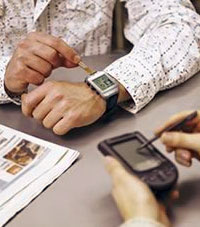 The watch itself is made of stainless steel, with a teensy weensy fold out stylus cunningly secreted in the strap buckle. Fossil have managed to fit in a USB socket and infra red port, along with three buttons and a rocker switch for onscreen navigation.
The watch itself is made of stainless steel, with a teensy weensy fold out stylus cunningly secreted in the strap buckle. Fossil have managed to fit in a USB socket and infra red port, along with three buttons and a rocker switch for onscreen navigation.
The unit has no waterproofing whatsoever, so a forgetful user doing the washing up while wearing the watch could be left with a very expensive – but utterly useless – bracelet.
Initial reports suggest that the battery life isn’t up to much cop either, with the watch struggling to survive a day with moderate usage (2 hours)
The good news is that it will run most of Palm’s immense application catalogue, although you may need a microscope to view some screens.
The watch is now available in two versions: the Fossil branded FX2008, priced at US$249.99 (£129/€188), and the Abacus branded AU5005, availably exclusively through Tiger Direct for US$199.99 (£104/€151)
Now, we like gadgets. And we like things that fit into watches. We love the idea of a wearable PDA but the more we looked at this watch the more it seemed about two years too late.
While there’s no denying that it’s an impressive feat to wedge so much technology into such a small form, it’s ten-ton, 70s-style girth makes it look as cool as a kipper tie.
Moreover, its poor battery life and lack of multimedia support suggests that it’s unlikely to score a hit with early adopters, and with smart phones offering far more functionality in a less dorky package, we can’t see this one taking off.
Howard Stringer: Sony Appoints British Chairman
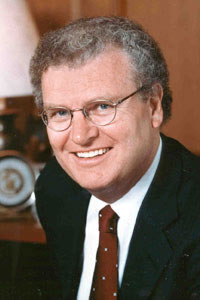 In an extraordinary move, Sony has named the Welsh-born head of its US operations, Sir Howard Stringer, as chairman and chief executive – a rare move for a major Japanese company to give its top post to a foreigner.
In an extraordinary move, Sony has named the Welsh-born head of its US operations, Sir Howard Stringer, as chairman and chief executive – a rare move for a major Japanese company to give its top post to a foreigner.
Sony’s board are set to agree to appoint the 63-year-old Stringer at an extraordinary meeting in Tokyo today, according to a company source.
Current CEO Nobuyuki Idei, 67, will step down to take responsibility for slumping earnings after what’s been described as ‘five rocky years’ at the helm.
(We think Sony is in a pretty strong position to rule in the time of Digital Lifestyles. They’ve got the content, they got tech and they’re got the cool. They just need to have a stong grip of how media has been changing, and what they can do to take best advantage of it. – Ed)
President Kunitake Ando is also rumoured to be up for the boot, to be replaced by Ryoji Chubachi, an executive deputy president currently in charge of electronics parts and production operations.
Tasked with boosting profitability at Sony, there’s a tough job ahead for Stringer and Chubachi, who are both mindful that their core electronics division has been wobbling in and out of the red amid tough price competition and a lack of big-hitting products.
In recent years Sony has failed to keep ahead of rivals Sharp Corp. and Matsushita Electric Industrial Co. in flat panel TVs and lost its lead in the portable music industry to Apple with its massively popular iPod player.
The market liked the sound of what it was hearing today, with shares of Sony rising 1.75 percent to 4,080 yen as of midday, outperforming the benchmark Nikkei average’s 0.68 percent gain.
Fellow Taffy-boy Stringer, holds dual British and U.S. citizenship and will become the first foreigner to run Sony.
The company are expected to announce its intention to make the proposed management changes before noon (10 pm EST) today, to be made official at a board meeting scheduled for after a general shareholders’ meeting in June.
Digital Music Forum :Summary
More than 400 industry professionals gathered for Digital Media Wire’s 5th annual Digital Music Forum at The French Institute in New York City on Wednesday. Discussion topics recalled the creation of the original Napster, examined the current business and legal environment, and looked ahead optimistically towards the future growth of subscription and mobile services.
In a widely anticipated keynote conversation, Napster founder Shawn Fanning described how early peer-to-peer file trading networks fundamentally changed consumer expectations for the breadth of music content available to them. Speaking about his new venture, Snocap, Fanning outlined his plans to create a central database for rights clearance while introducing a digital identification and acoustic fingerprinting architecture for file trading systems. Fanning expressed his hope that the creation of a trusted third party to manage rights administration will create an environment in which the interests of peer-to-peer companies, retailers, and content owners will not be in conflict.
Technology and rights management remained in the spotlight during a panel discussion about the forthcoming MGM v. Grokster case that will go before the Supreme Court on March 29th. At issue, according to Digital Media Association Executive Director Jonathan Potter, is whether a software developer can be held liable for the actions of its users. Martin Elgison, a partner at Alston & Bird, advocated separate assessments of legality for a company’s business conduct and the associated technology. Jim Delong, senior fellow at The Progress & Freedom Foundation, agreed that the courts need to examine a company’s underlying business model and question whether it depends on copyright infringement.
Speaking to technology’s current effects on artist management, Nettwerk Productions CEO Terry McBride conveyed that digitization currently represents a mixed opportunity for his clients like Avril Lavigne, Sarah McLachlan and Barenaked Ladies. On the one hand, McBride reported, Barenaked Ladies sold more than 900,000 live tracks in the past year and archives 150 concerts for sale online. On the other, he voiced concern that his artists’ catalog sales are being negatively affected by peer-to-peer file trading. On the whole, McBride was bullish on technology’s long-term potential, both for management companies seeking to provide for all their clients’ needs, as well as for artists pursuing long term careers.
In an afternoon keynote, Yahoo Music Vice President and General Manager David Goldberg highlighted the opportunities created by consumers’ desires to discover and control their music in an on-demand environment. Goldberg predicted the continued emergence of subscription-based digital music services, as well as the use of customization and community functionality to drive traffic and consumer engagement. According to Goldberg, playlists will become the “killer app of music” for users confronted with more than a million tracks at their fingertips and services will need to focus on delivering appropriate recommendations to create the ultimate listening experience.
MSN Marketplaces General Manager Mike Conte addressed Microsoft’s digital music effort which initially launched last October as an a-la-carte download service. According to Conte, Microsoft is principally involved with music to drive traffic and advertisers to MSN.com while contributing to the company’s strategy to build an overall ecosystem for digital media. While emphasizing that Microsoft’s plans were still in their early stages, Conte echoed Goldberg in emphasizing the importance of building community to engage customers and alluded to future digital music integration with messaging, blogging and playlist capabilities. Conte also agreed with predictions for the future growth of subscription services, citing company research indicating that the younger the consumer, the lower the likelihood that they desire to own their music.
During morning and afternoon panels, participants painted a positive future for the mobile music marketplace. Sony BMG Senior Vice President Thomas Gewecke noted that mobile services continue to be the dominant digital revenue stream outside the United States. Gewecke further predicted that mobile devices will become the dominant method for initial music purchases, even if the content is eventually consumed on another platform. Sprint General Manager of Wireless Music and Personalization Nancy Beaton reported that music represents an important way for the company to boost its current average monthly bill of $62. Beaton also cited successful ringtone launches with artists like Beyonce and 50 Cent, with both reaching platinum sales levels.
Thanks to Wesley Radez (wradez @ digitalmusicnews.com) over at Digital Music News for this report.